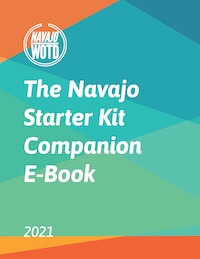ga
The word gah in navajo means rabbit. Gahtsoh, or big rabbit, refers to a jackrabbit (which is actually a hare).
There are many stories about gah and mą’ii (coyote), especially when it comes to the latter hunting the former. In nearly all cases, gah continually taunts mą’ii and then proceeds to devise an escape if he is trapped.
In one instance, coyote was out all day trying to catch a rabbit for food. One rabbit decided to play with coyote, so he went out into the open where he would be seen. Coyote spotted him and immediately pursued rabbit all over. But rabbit was getting tired so he hopped right into a hole in the ground.
Coyote reached in as far as he could, all the while shouting that he was going to eat the rabbit. Rabbit, still playing with mą’ii, cried back, “I’m going to die! You are going to eat me! How will you kill me?”
“By using a big stick! I’ll twist your fur and pull you out that way!” Coyote explained as he rushed away to find his stick. He came rushing back, plunging the stick into the hole in the ground. Rabbit was still having fun, though.
Every time, rabbit grabbed the stick and held on until coyote almost had him within reach. Then he would let go and coyote would tumble backwards. Coyote stopped after half a day of trying. Finally, rabbit shouted back, “I’m going to die! You are going to eat me! How will you kill me?”
“I’ll smoke you out of your hole with some pitch!” Coyote replied. He rushed off and returned shortly with a pile of wood and some pitch. Arranging it all over the rabbit’s burrow, he lit everything on fire. Rabbit cried out, “You’re killing me! Make it bigger!”
Coyote blew onto the fire and it grew, and still rabbit cried out, “More! Make it hotter! I am almost dead!” So coyote obliged and leaned in further towards the fire and blew harder to make it bigger. “You’re almost there!” yelled rabbit over the flames.
Coyote was at last as close as he could get to the flames, blowing frantically to make it bigger. Rabbit finally said, “There! You got it!” and coyote’s face perked up, anticipating rabbit’s exit. Inside the burrow, rabbit quickly charged towards the coals, shooting out of the burrow and sending pieces of coal into coyote’s face. Coyote cried out and rabbit got away.
This is how, they say, coyote got the dark spots on his face.
